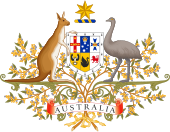Data Availability and Transparency Act 2022
The Data Availability and Transparency Act 2022 (Cth) (DAT Act) is an Act of the Australian Parliament that authorises and regulates access to data held by the Australian Government.[1]
| Data Availability and Transparency 2022 | |
|---|---|
 | |
| Parliament of Australia | |
| |
| Citation | No 11 of 2022 [1] |
| Territorial extent | Australia |
| Passed by | Australian House of Representatives |
| Passed | 30 March 2022 |
| Passed by | Senate |
| Passed | 30 March 2022 |
| Assented to | 31 March 2022 |
| Commenced | 1 April 2022 |
| Date of expiry | 1 April 2027 |
| Legislative history | |
| First chamber: Australian House of Representatives | |
| Bill title | Data Availability and Transparency Act 2020 |
| Introduced by | Stuart Robert |
| First reading | 9 December 2020 |
| Second reading | 30 March 2022 |
| Third reading | 30 March 2022 |
| Second chamber: Senate | |
| Bill title | Data Availability and Transparency Act 2022 |
| First reading | 30 March 2022 |
| Second reading | 30 March 2022 |
| Third reading | 30 March 2022 |
| Final stages | |
| Finally passed both chambers | 30 March 2022 |
| Keywords | |
| data sharing | |
| Status: In force | |
The Australian Parliament passed the Act into law in March 2022.[2][3][4][5][6] The Act came into effect on 1 April 2022.[7]
The Act creates a public-sector data sharing scheme that permits Australian Government (Commonwealth) bodies to share their data with other Commonwealth bodies, Australian state or territory government bodies, or Australian universities;[8] these entities must be accredited, before they can obtain and use the data.[8][9]
The Act requires that any sharing of data under the scheme must:
- be for one or more of the permitted data sharing purposes;[8]
- be consistent with data sharing principles;[8] and
- within a data sharing agreement.[8]
The Act specifically precludes sharing of data under the scheme for law enforcement-related purposes or national security purposes.[8] If the shared data includes personal information, privacy protections also apply.[8][9]
The Act permits sharing of data under the scheme for three purposes only:[8]
- delivery of government services;
- informing government policy and programs; and
- research and development.
The Act establishes a National Data Commissioner to be the regulator of this data sharing scheme.[8]
External links
editReferences
edit- ^ Data Availability and Transparency Act 2022 (Cth)
- ^ Hendry, Justin (2022-03-31). "Public sector data sharing laws pass parliament with Labor changes". iTnews. Retrieved 2023-05-30.
- ^ Burton, Tom (2022-04-01). "End to multiple forms as 'tell us once' becomes possible". Australian Financial Review. Retrieved 2023-06-15.
- ^ Hendry, Justin (2023-03-17). "Give private sector access to govt data: Productivity Commission". InnovationAus. Retrieved 2023-06-16.
- ^ Cho, George (2023). Information Technology Law in Australia. Kluwer Law International. ISBN 9789403522968.
- ^ Hendry, Justin (2022-07-28). "Data sharing regime "open for business" as accreditation begins". IT news. Retrieved 2023-06-16.
- ^ Keelara, R. and P. Haywood (2023), "Building the data and digital foundations of health systems", in Ready for the Next Crisis? Investing in Health System Resilience, OECD Publishing, Paris, doi:10.1787/9b8a7ce8-en. page 386
- ^ a b c d e f g h i Witzleb, Normann (2023-04-12), Hennemann, Moritz; Lewinski, Kai von; Wawra, Daniela; Widjaja, Thomas (eds.), "Responding to Global Trends? Privacy Law Reform in Australia", Data Disclosure, De Gruyter, pp. 147–168, doi:10.1515/9783111010601-009, ISBN 978-3-11-101060-1
- ^ a b Katie Logos, Russell Brewer, Colette Langos, Bryce Westlake, Establishing a framework for the ethical and legal use of web scrapers by cybercrime and cybersecurity researchers: learnings from a systematic review of Australian research, International Journal of Law and Information Technology, Volume 31, Issue 3, Autumn 2023, Pages 186–212, https://doi.org/10.1093/ijlit/eaad023